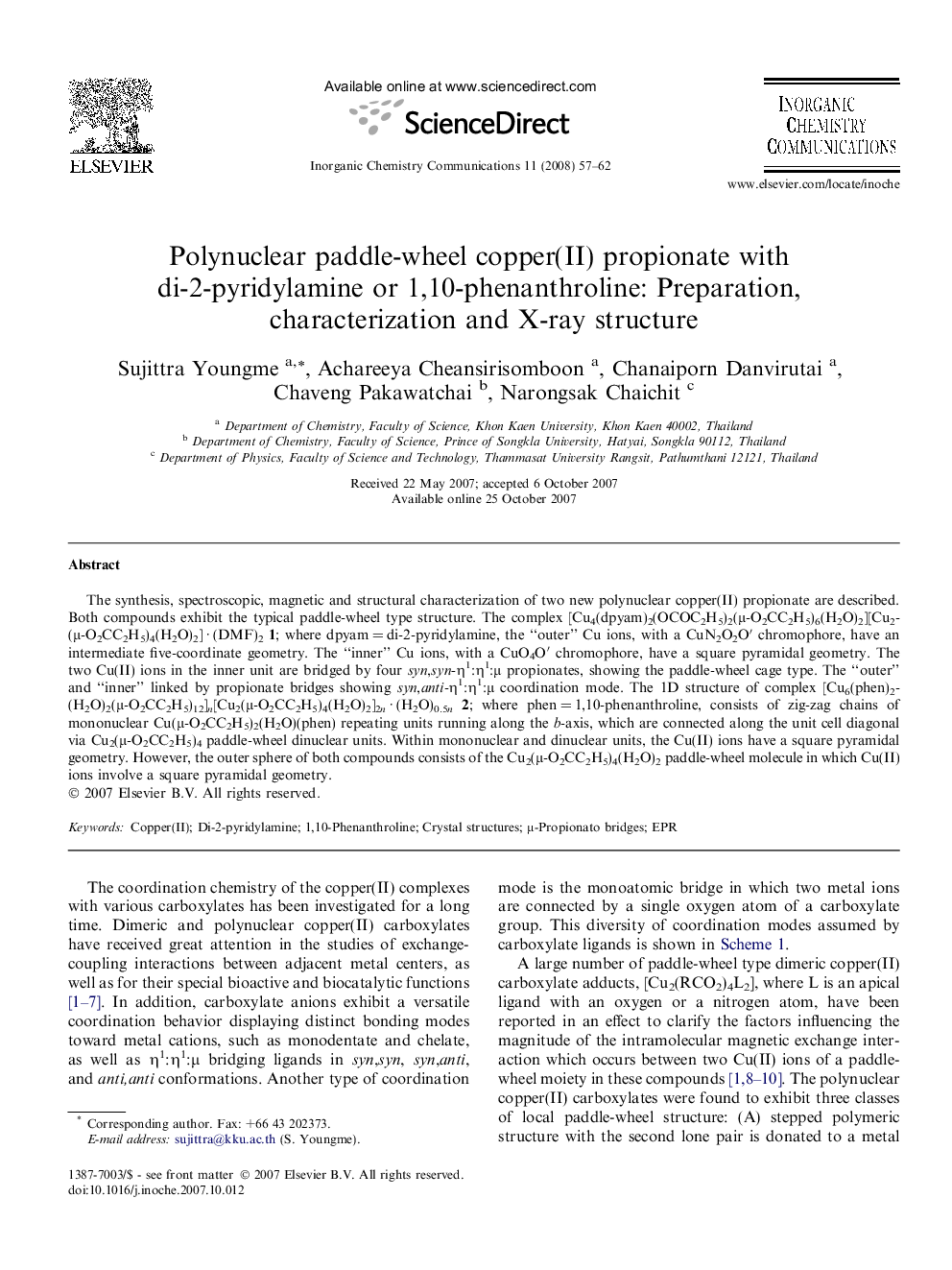| کد مقاله | کد نشریه | سال انتشار | مقاله انگلیسی | نسخه تمام متن |
|---|---|---|---|---|
| 1304832 | 974854 | 2008 | 6 صفحه PDF | دانلود رایگان |

The synthesis, spectroscopic, magnetic and structural characterization of two new polynuclear copper(II) propionate are described. Both compounds exhibit the typical paddle-wheel type structure. The complex [Cu4(dpyam)2(OCOC2H5)2(μ-O2CC2H5)6(H2O)2][Cu2(μ- O2CC2H5)4(H2O)2] · (DMF)21; where dpyam = di-2-pyridylamine, the “outer” Cu ions, with a CuN2O2O′ chromophore, have an intermediate five-coordinate geometry. The “inner” Cu ions, with a CuO4O′ chromophore, have a square pyramidal geometry. The two Cu(II) ions in the inner unit are bridged by four syn,syn-η1:η1:μ propionates, showing the paddle-wheel cage type. The “outer” and “inner” linked by propionate bridges showing syn,anti-η1:η1:μ coordination mode. The 1D structure of complex [Cu6(phen)2(H2O)2(μ-O2CC2H5)12]n[Cu2(μ-O2CC2H5)4(H2O)2]2n · (H2O)0.5n2; where phen = 1,10-phenanthroline, consists of zig-zag chains of mononuclear Cu(μ-O2CC2H5)2(H2O)(phen) repeating units running along the b-axis, which are connected along the unit cell diagonal via Cu2(μ-O2CC2H5)4 paddle-wheel dinuclear units. Within mononuclear and dinuclear units, the Cu(II) ions have a square pyramidal geometry. However, the outer sphere of both compounds consists of the Cu2(μ-O2CC2H5)4(H2O)2 paddle-wheel molecule in which Cu(II) ions involve a square pyramidal geometry.
The synthesis, spectroscopic, magnetic and structural characterization of two new polynuclear copper(II) propionate are described. Both compounds exhibit the typical paddle-wheel type structure. The complex [Cu4(dpyam)2(OCOC2H5)2(μ-O2CC2H5)6(H2O)2][Cu2(μ-O2CC2H5)4(H2O)2] · (DMF)21, where dpyam = di-2-pyridylamine, the “outer” Cu ions, with a CuN2O2O′ chromophore, have an intermediate five-coordinate geometry. The “inner” Cu ions, with a CuO4O′ chromophore, have a square pyramidal geometry. The two Cu(II) ions in the inner unit are bridged by four syn,syn-η1:η1:μ propionates, showing the paddle-wheel cage type. The “outer” and “inner” linked by propionate bridges show syn,anti-η1:η1:μ coordination mode. The 1D structure of complex [Cu6(phen)2(H2O)2(μ-O2CC2H5)12]n[Cu2(μ-O2CC2H5)4(H2O)2]2n · (H2O)0.5n2; where phen = 1,10-phenanthroline, consists of zig-zag chains of mononuclear Cu(μ-O2CC2H5)2(H2O)(phen) repeating units running along the b-axis, which are connected along the unit cell diagonal via Cu2(μ-O2CC2H5)4 paddle-wheel dinuclear units. Within mononuclear and dinuclear units, the Cu(II) ions have a square pyramidal geometry. However, the outer sphere of both compounds consists of the Cu2(μ-O2CC2H5)4(H2O)2 paddle-wheel molecule in which Cu(II) ions involve a square pyramidal geometry.Figure optionsDownload as PowerPoint slide
Journal: Inorganic Chemistry Communications - Volume 11, Issue 1, January 2008, Pages 57–62